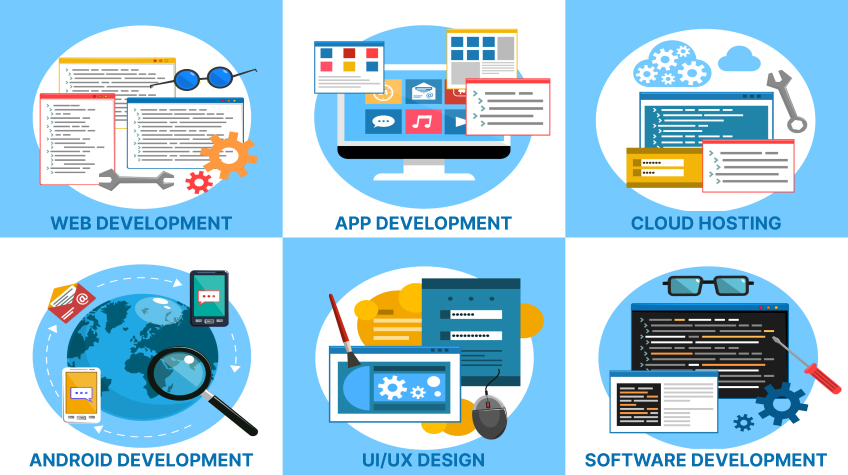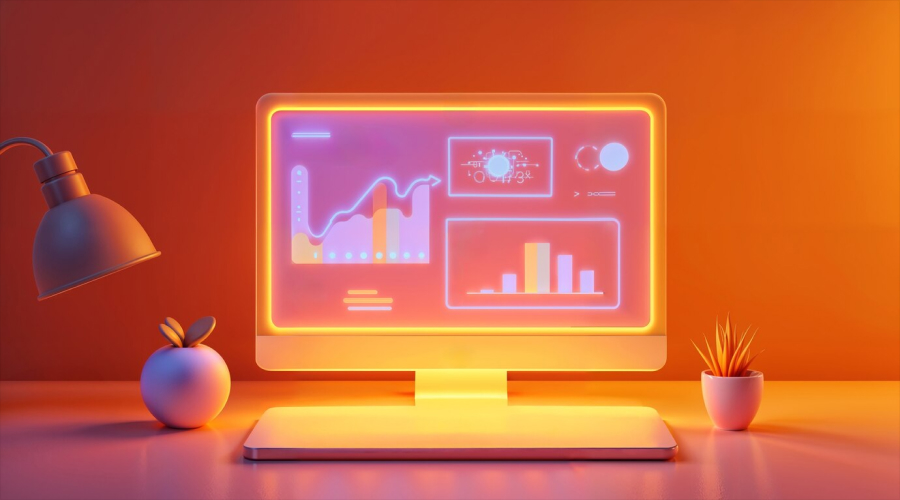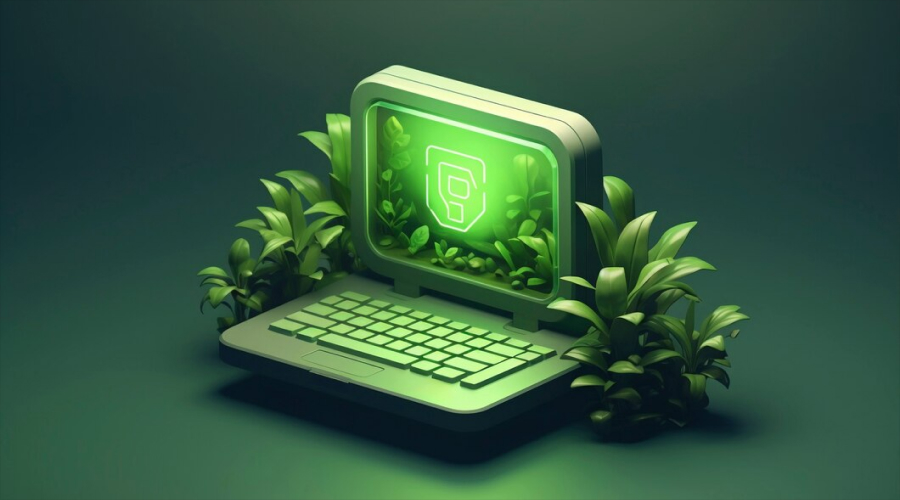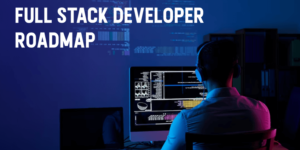
Software development is a broad and constantly evolving field that includes several branches and approaches to develop sophisticated applications, platforms and solutions, designed and oriented to fulfill several purposes. Software development is broken down into mobile application development and web applications, enterprise software development and embedded systems software development among others.
These all are differentiated by the type of work they solve, the domains they operate in and the tools, programming languages and frameworks used. In this informative guide, understand the different types of software development to choose the right approach, technology stack and expertise required for your business or work.
List of Software Development Types
Here are the different kinds of software development:
1. Front-End Development
Front-end development is more concerned with the user interface and the experience that the user is likely to have when using the application, mostly, the part of the application that a user is going to be interacting with most.
It consists of structures such as charts and bar graphs, alignments and links and controlling graphics like buttons and animations using HTML, CSS and JavaScript. Front-end developers strive to create stunning designs that meet end-user needs by supporting applications across devices and browsers.
2. Back-End Development
Back-end development is the process of creating and overseeing the server implementations, databases and application programming interfaces (APIs) that drive an application from the background. It ensures that the data is processed, stored and transmitted well to the front end.
Back-end developers for web or application development deal with languages including Python, Java, Ruby, PHP and frameworks such as Node.js, Django or Spring. They also work with databases, such as MySQL, PostgreSQL or MongoDB.
3. API Development
API development work is defined as the process of designing and implementing the application programming interface that can facilitate the interaction of different applications. It is more centered on developing endpoints and functionalities that are usable by other developers or applications.
Some of them are RESTful APIs, GraphQL and development tools such as Flask, Express.js or FastAPI. Developers use programming languages like Python, Java, JavaScript and Go while developing APIs to enhance integration, stability and performance.
4. Web Development

Web development means web designing and the process of building websites and web applications using front-end and back-end technologies. The front end is all about the user interface built using HTML, CSS and JavaScript while the back end is about handling the content management system on the server side with languages such as Python, PHP or Java. Frameworks such as React, Angular and Django help in the making of responsive, functional and dynamic web experiences.
5. Mobile App Development
Mobile app development services is focused on developing apps for smartphones and tablets which is mostly centered on the iOS and Android applications. Currently, it is coded in Swift or Objective-C for iOS, Kotlin or Java for Android and in cross-platform frameworks like Flutter and React Native. It helps to write effective scripts providing smooth work and convenient navigation for mobile users.
Also Read: 5 App Development Trends for 2025
6. Desktop Application Development
Desktop application development is centered on creating a program that directly operates on an operating system such as Windows, macOS or Linux. It is coded using languages namely, C#, Java, C++ or Python and frameworks such as WPF, .NET or Qt. These applications are designed to contain highly useful features and they are also designed to run on the desktop environment.
7. Game Development

Game development is a process of creating video games, from concept to implementation and testing on personal computers, consoles or mobile devices. Developers prefer using languages including C++, C# and Python, while the game engines are Unity and Unreal Engine. It includes graphics, sound, artificial intelligence and game mechanics interfaces to bring exciting games that consumers will be willing to play.
8. Embedded Systems Development
The embedded systems development is aimed at programming special equipment that is simultaneously built-in, with hardware components and software codes that are designed to perform a single task. These systems are applied in “Internet of Things” devices, automotive electronics and medical equipment.
C, C++, Python and Arduino, Raspberry Pi, real-time operating systems (RTOS) are among the languages and platforms used by developers to optimize and make products reliable.
9. DevOps
DevOps services is an approach that connects application development with IT operations to enable enhanced cooperation and the process of delivery. More emphasis is placed on continuous integration and continuous delivery to ramp up software deployment.
It is possible to use docker, Kubernetes, Jenkins and special tools for managing infrastructure. Terraform and scripting languages like Python and Bash for automation are used.
10. AI and ML Development

Artificial Intelligence and Machine Learning development focuses on the development of systems that on their own can learn from the data and come up with decisions. Developers apply algorithms and models to design intelligent applications.
Some programming languages used in the development include Python, R and Java while frameworks include TensorFlow, Pytorch and Scikit-learn. This field includes natural language processing, computer vision and even predictive analysis.
11. Blockchain Development
Blockchain involves creating decentralized applications (dApps) and distributed ledgers that make sure transactions are secure, transparent and cannot be tampered with. Developers prefer using languages that include Solidity for Ethereum Smart Contracts, Go and Rust for blockchain networks. Platforms like Hyperledger Fabric, Ethereum and Polkadot Chain are familiar platforms for building decentralized platforms in finance, supply chain and others.
12. AR and VR Development
AR (Augmented Reality) and VR (Virtual Reality) development focuses on creating immersive digital experiences. AR overlays digital content in the real world using devices like smartphones or smart glasses, while VR creates entirely virtual environments for users to interact with. Developers use tools like Unity, Unreal Engine and programming languages such as C# and C++ to build these experiences.
13. Enterprise Software Development
It is the process of developing big-scale applications intended for use by an enterprise for its operations, such as customer relationship management (CRM) and enterprise resource planning (ERP) systems. These applications are based on scalability, integration and efficiency of the work being done.
Business applications are created using skill-based programming languages such as Java, C#, Python and frameworks like .NET, Spring or SAP, offering deeper enterprise level solutions.
14. Cybersecurity Development

Cybersecurity development refers to the creation of software and systems that would guard against cyber threats and cyber-attacks. It encompasses designing measures, secret codes and techniques for the protection of data coupled with shields in defending networks.
To provide enhanced security to the application, developers today adopted languages like Python, C++ and Java, besides leveraging security frameworks and tools like OWASP, Metasploit, Wireshark, etc.
15. Data Science and Big Data Development
Data science and big data development deal with making sense of large datasets to extract useful insights toward decision-making. In this type of development, developers work with languages such as Python, R and SQL, as well as tools like Hadoop, Spark and TensorFlow, in order to work with the data.
This field incorporates principles of Artificial Intelligence including Machine learning, Statistical modeling as well as Data mining to process large volumes of information.
16. IoT Development
IoT (Internet of Things) development focuses on the construction of devices that are capable of exchanging information with each other and with the cloud to gather data, analyze the specified data and make the corresponding decisions.
Some of the languages used by developers include Python, C and Java while IoT platforms that have been used are Raspberry Pi, Arduino, mqtt and so on. Business domains of IoT are healthcare, agriculture, smart homes and many more.
17. Cloud Computing Development
Cloud computing development is concerned with creating and implementing applications and services within the cloud environments, which are AWS, Azure, Google Cloud and other platforms. Programs such as Python, Java and Go combined with Kubernetes, Docker and Terraform tools make it possible for developers to create sustainable, portable and affordable solutions.
This makes it possible for businesses to acquire products and tap into structures from a distance.
18. Robotic Process Automation (RPA)
Robotic Process Automation (RPA) is an approach where robots are programmed to work for businesses to execute manual, conventional and repetitive functional activities. Developers utilize RPA tools from UiPath, Automation Anywhere and Blue Prism as well as scripting languages such as Python and VB.
NET RPA helps organizations to automate routine tasks, minimize human mistakes and improve performance in fields including data entry, customer satisfaction and report conclusion.
19. Green Software Development

Green software development is aimed at developing software that consumes less energy at the time of its execution. It focuses on optimizing code to enhance performance and minimize source consumption such as CPU or memory, network and other resources.
Techniques include algorithm optimization, data storage and efficient cloud infrastructure management. The aim is to minimize the carbon footprint of the digital solution while ensuring functionality and scalability are maintained.
Also Read: Use AI in Software Development
Conclusion
In conclusion, every field within software development offers a unique contribution to different industries, thus making the field very vast and constantly evolving. From front-end and back-end development to all the new areas such as AI, blockchain and IoT, developers use many tools, languages and frameworks to create innovative solutions. Understanding the different types of software development will help organizations pick the right approach for their needs and drive efficiency, scalability and growth in this digital-first world.






